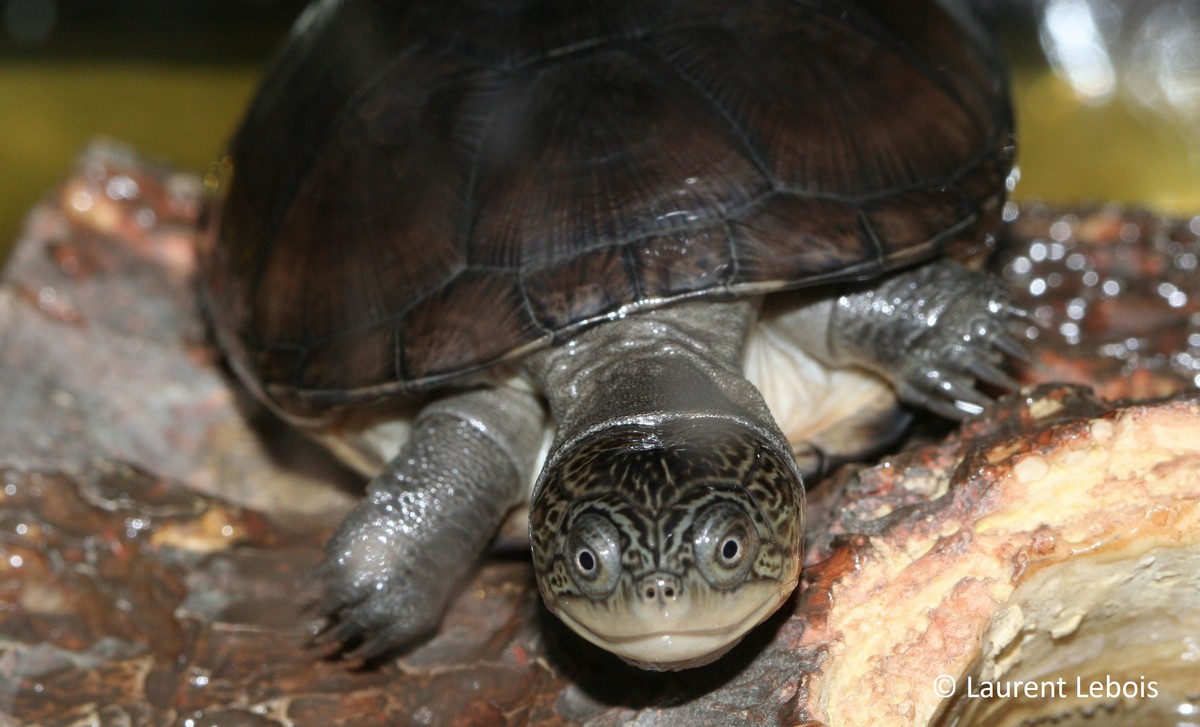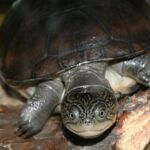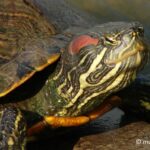
- Scientific name : Pelusios castaneus (Schweigger, 1812)
- Common name: African mud turtle, Swamp terrapin.
- Order : Testudines
- Family : Pelomedusidae
Description
Morphology. Medium sized freshwater turtle. Pelusios castaneus possess two intergular scutes on the plastron (characteristic of the Pleurodira suborder), does not have a cervical scute (characteristic of the Pelusomidae family), and present a hinge between the pectoral and abdominal scutes of the plastron. The carapace is oblong or elliptical, and enlarged on the posterior part. The colour of the carapace and plastron is generally black, but may vary towards lighter shades of brown, or even yellow for the plastron. The colour of the head varies from olive to brown, and is marked with black spots. The limbs are poorly webbed and possess powerful claws (Bour et al., 2016).
Standard body size (carapace length). 220 to 285 mm (Bour et al., 2016)
Sexual dimorphism. Males are generally smaller than females.
Variations. Some characters, such as the pigmentation and sinuosity of the head spots or the peripheral pigmentation of the plastron, seem to vary more or less regularly along the East-West axis of its native range, as well as according to the environment, from savannahs to forest environments (Bour et al., 2016).
Possible confusion with other species.
Distribution
Native. Mauritania (possibly), Mali (possibly), Burkina Faso, Cap-verde, Senegal, Gambia, Guinea-Bissau, Guinea, Sierra Leone, Liberia, Ivory Coast, Ghana, Togo, Benin, Nigeria, Cameroun, Central African Republic, Equatorial Guinea, Gabon, Sao Tomé and Pincipe, Republic of the Congo, Democratic Republic of the Congo, Angola (Burger et al., 2004; Chirio and Ineich, 2006; Rhodin et al., 2010; Ullenbruch et al., 2010; Böhme et al., 2011; Bour et al., 2016; Kindler et al., 2016; Marques et al., 2018; Nneji et al., 2019; Luiselli et al., 2021).
Introduced. Caribbean: Guadeloupe (Rhodin et al., 2010; Fritz et al., 2011; Bour et al., 2016).
One observation reported in Martinique, but no established population to date (INPN OpenObs, 2021).
One observation also reported in La Réunion, but no established population to date (Cornuaille et al., 2021).
Biology and ecology
Habitat. Pelusios castaneus inhabit different freshwater environments, such as ponds and lakes, swamps, mangroves and rivers of West-African forested habitats and savannahs (Bour et al., 2016; Kindler et al., 2016; Luiselli et al., 2021).
Diet. Omnivore, P. castaneus adapt its diet to the ressources available in its environment. The species can feed on plants (including seeds and fruits), molluscs, crustaceans, insects, fishes and amphibians (Bour et al., 2016; Luiselli et al., 2021).
Reproduction. In natural environment, the nesting season takes place during the dry season. Due to the extent of its range, the egg-laying period varies by region: egg-laying occurs between February and March in the Northern Hemisphere, and between July and September in the Southern Hemisphere. Nests contain three to nine eggs, and females lay eggs twice a year (Bour et al., 2016).
Behaviour. In its native range, the dry season can lead to the temporary disappearance of water ponds. The species then aestivate, buried in the mud or in the sand, awaiting the return of more favourable conditions.
Impact and management of introduced populations
Impact. Little is known about the impact of Pelusios castaneus on native ecosystems in introduced regions.
Management. No targeted control measures have been established in the regions where the species has been introduced.
Bibliography
- Böhme, W., Rödel, M.-O., Brede, C., & Wagner, P. (2011). The reptiles (Testudines, Squamata, Crocodylia) of the forested southeast of the Republic of Guinea (Guinée forestière), with a country-wide checklist. Bonn Zoological Bulletin, 60, 35–61.
- Bour, R., Luiselli, L., Petrozzi, F., Segniagbeto, G., & Chirio, L. (2016). Pelusios castaneus (Schweigger 1812) – West African Mud Turtle, Swamp Terrapin. Conservation Biology of Freshwater Turtles and Tortoises, 5.
- Burger, M., Branch, W. R., & Channing, A. (2004). Amphibians and Reptiles of Monts Doudou , Gabon: species turnover along an elevational gradient. California Academy of Sciences Memoir, 28, 145–186.
- Chirio, L., & Ineich, I. (2006). Biogeography of the reptiles of the Central African Republic. African Journal of Herpetology, 55, 23–59.
- Cornuaille, J., Probst, A. P. J., Maran, J., & Massary, J. De. (2021). Distribution géographique: une Péluse de Schweigger Pelusios castaneus (Schweigger, 1812) capturée à Saint-Leu (La Réunion). Bulletin Phaethon, 53, 84–85.
- Fritz, U., Branch, W. R., Hofmeyr, M. D., Maran, J., Prokop, H., Schleicher, A., … Hundsdörfer, A. K. (2011). Molecular phylogeny of African hinged and helmeted terrapins (Testudines: Pelomedusidae: Pelusios and Pelomedusa). Zoologica Scripta, 40, 115–125. h
- Kindler, C., Moosig, M., Branch, W. R., Harvey, J., Kehlmaier, C., Nagy, Z. T., … Fritz, U. (2016). Comparative phylogeographies of six species of hinged terrapins (Pelusios spp.) reveal discordant patterns and unexpected differentiation in the P. castaneus/P. chapini complex and P. rhodesianus. Biological Journal of the Linnean Society, 117, 305–321.
- Luiselli, L., Demaya, G. S., Benansio, J. S., Petrozzi, F., Akani, G. C., Eniang, E. A., … Dendi, D. (2021). A comparative analysis of the diets of a genus of freshwater turtles across Africa. Diversity, 13.
- Marques, M. P., Ceríaco, L. M. P., Blackburn, D. C., & Bauer, A. M. (2018). Diversity and distribution of the amphibians and terrestrial reptiles of Angola atlas of historical and bibliographic records (1840-2017). Proceedings of the California Academy of Sciences, 65, 1–501.
- Nneji, L. M., Adeola, A. C., Okeyoyin, A., Oladipo, O. C., Saidu, Y., Samuel, D., … Ugwumba, A. A. A. (2019). Diversity and distribution of amphibians and reptiles in Gashaka Gumti National Park, Nigeria. Herpetology Notes, 12, 543–559.
- Rhodin, A., van Dijk, P. P., Iverson, J., & Shaffer, B. (2010). Turtles of the World, 2010 Update: Annotated Checklist of Taxonomy, Synonymy, Distribution, and Conservation Status. Conservation Biology of Freshwater Turtles and Tortoises, 000.85-000.164.
- Ullenbruch, K., Grell, O., & Boehme, W. (2010). Reptiles from southern Benin, West Africa, with the description of a new Hemidactylus (Gekkonidae), and a coutry-wide checklist. Bonn Zoological Bulletin, 57, 31–54.





